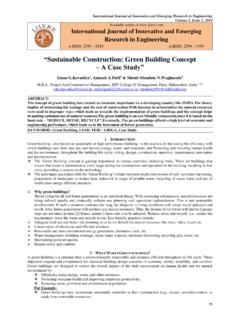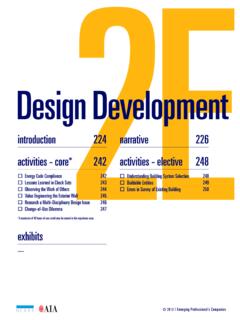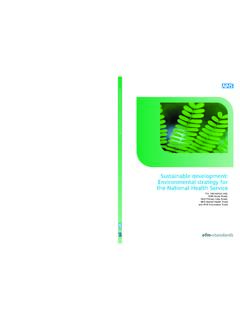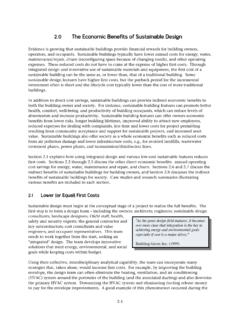Transcription of WATER SENSITIVE URBAN DESIGN - A STORMWATER …
1 WATER SENSITIVE URBAN DESIGN - A STORMWATER MANAGEMENTPERSPECTIVEbySara D. Lloyd1, Tony Wong1and Christopher J. Chesterfield21 Cooperative Research Centre for Catchment Hydrology 2 Melbourne WATER CorporationIndustry ReportReport 02/10 September 2002 Lloyd, Sara (Sara Dorothy), 1972- . WATER SENSITIVE URBAN DESIGN : a STORMWATER management 1 876006 91 Storm sewers - Australia. 2. URBAN runoff - Australia. 3. WATER quality management. 4. WATER conservation. 5. URBAN hydrology - Australia. I. Wong, Tony H. F. II. Chesterfield,Christopher J. III. Cooperative Research Centre for CatchmentHydrology. IV. : URBAN AreasStormwater ManagementDesign DataWater Quality (Treated Waters)Best PracticeDevelopment AreasEnvironmental ManagementFlow ControlStorm Sewage TreatmentStorm Sewerage SystemsFiltration (Biological)Cost Effectiveness Cooperative Research Centre for Catchment Hydrology 2002 Cooperative Research Centre for Catchment HydrologyCentre Office: Department of Civil Engineering,PO Box 60, Monash University, Victoria 3800 : (03) 9905 2704 Fax: (03) 9905 5033 Website: were provided by: Sara Lloyd Don McCarthy Melbourne WaterOther titles in the CRC for Catchment Hydrology Industry ReportSeries: URBAN STORMWATER Pollution Controlling Sediment and Nutrient Movement within Catchments development of an Improved Real-time Flood Forecasting Model STORMWATER Gross Pollutants Predicting WATER Yield from Mountain Ash Forest Catchments How much Rainfall becomes Runoff?
2 Loss Modelling for FloodEstimation Irrigation Salt Bay Export and Salinity Management Managing STORMWATER using Constructed Wetlands Managing Sediment Sources and Movement in Forests: The ForestIndustry and WATER Quality The Reuse Potential of URBAN STORMWATER and WastewaterMany CRC Industry and Technical Reports are available as AdobeAcrobat files (.pdf) at Industry Report is one of a series prepared by the Cooperative Research Centre (CRC) for Catchment Hydrology to help provide agencies andconsultants in the Australian land and WATER industry with improved ways of managing catchments. Since we published our first CRC IndustryReport in 1997, the response has been overwhelming. It is clear that land and WATER managers appreciate material written specifically for this series of reports and other forms of technology transfer, industry is able to benefit from the Centre s high-quality, comprehensiveresearch programs: Predicting Catchment Behaviour Land-use Impacts on Rivers sustainable WATER Allocation URBAN STORMWATER Quality Climate Variability River RestorationThis particular Report presents key findings from Project in the CRC s URBAN STORMWATER Quality Research Program: STORMWATER BestManagement Practices.
3 The CRC welcomes feedback on the work reported here, and is keen to discuss opportunities for further collaboration with industry to expedite theprocess of getting research into VertessyDirector, CRC for Catchment HydrologyiiiPrefaceIn response to the need for reliable, cost-effective, environmentally-friendly, robust and aesthetically-pleasing STORMWATER treatment measures, theCooperative Research Centre (CRC) for Catchment Hydrology undertook research to develop new, and refine existing STORMWATER qualityimprovement practices. The integration of these and other WATER conservation practices into URBAN DESIGN is referred to as WATER SENSITIVE UrbanDesign (WSUD) and its principles can apply to individual houses, streetscapes and precincts or to whole to successfully applying WSUD principles to URBAN development is an understanding of the performance capabilities of structuralstormwater management strategies, their life cycle costs and market acceptance.
4 This report centres on the DESIGN process, construction activitiesand monitoring of environmental, social and economic performance indicators associated with the Lynbrook Estate Demonstration Project. AcknowledgementsMany people have contributed to the success of the Lynbrook Estate Demonstration Project and research. Many thanks to: The URBAN and Regional Land Corporation and in particular Bernie Porter Other key members of the Lynbrook Estate DESIGN team: Neville Worme, Peter Quigley and Rud Lindley of KLM development consultants, BarryMurphy of Murphy DESIGN Group and Scott Seymour of Melbourne WATER Corporation The URBAN and Regional Land Corporation, Melbourne WATER Corporation and ResearchWise (funding and development of market research) Staff, postgraduates and summer students from Department of Civil Engineering and the CRC for Catchment Hydrology at Monash University(assistance in conducting field experiments) Thiess Services (installation and maintenance of field monitoring stations) WATER Studies Centre, Monash University ( WATER quality analysis)We are also grateful to.
5 David Perry (CRC for Catchment Hydrology) for comments on the text of the report and valuable assistance with its publication Cathy Sage (Sage Words) for editing the report Tim Fletcher and Hugh Duncan (CRC for Catchment Hydrology) for comments on the final draft Robyn Materazzo and Lisa Hailes (MatGraphics) for DESIGN and printingivContentsForewordiiiPrefaceiv AcknowledgementsivIntroduction1 What is WATER SENSITIVE URBAN DESIGN (WSUD)?2 Developing a STORMWATER management scheme3 Identifying project objectives4 Multi-disciplinary DESIGN team4 Stakeholder consultation4 Best planning practices (BPPs)5 Site analysis5 Land capability assessment5 Land-use plans5 Non-structural best management practices6 Structural best management practices7 The treatment train approach8 Selecting appropriate structural best management practices8 Flow control8 WATER quality improvement9 Treatment effectiveness9 DESIGN issues10 Cost considerations10 Assessment of Structural STORMWATER Management Strategies: MUSIC software10 Implementation of a STORMWATER management scheme.
6 The Lynbrook Estate Demonstration Project12 Overview12 Engaging stakeholders14 DESIGN details and construction activities associated with the bio-filtration systems15 Capital costs of bio-filtration systems19 Assessing the effectiveness of bio-filtration systems for STORMWATER treatment19 Flow characteristics and WATER quality improvements associated with the bio-filtration system during a series of small storm events21 Market acceptance of bio-filtration systems22 On-going research24 The current status of WATER SENSITIVE URBAN DESIGN in Australia25 Creating an effective planning framework26 Cost-benefit assessment of STORMWATER management schemes28 CRC for Catchment Hydrology research activities30 Summary31 Further reading32 Glossary34 Appendix A: Life cycle cost assessment35 Litter and sediment traps35 Wetlands and vegetated swales36 Temporal changes in maintenance costs37 Appendix B: Construction issues38 Local government initiatives38vviBio-filtration system along Lynbrook Boulevard at Lynbrook Estate, VictoriaIntroductionUrban catchments have a complicated WATER cycle involving watersupply, wastewater disposal and STORMWATER drainage that are, inmost Australian URBAN areas, managed as independent systems(Figure 1).
7 High quality WATER is harvested from catchments oftensome distance away from URBAN areas, treated and delivered to meetdomestic and industrial WATER demands. Wastewater generated fromurban areas is conveyed to regional wastewater treatment facilitiesand then discharged to the environment (for example, to rivers orbays). STORMWATER generated from URBAN areas is often conveyedefficiently to designated trunk STORMWATER drainage systems to reducestormwater ponding and pressures on the nation s WATER resources, and increasingawareness of the environmental impacts of STORMWATER andwastewater discharges on receiving WATER values has led to the waterindustry considering alternative approaches to manage the urbanwater cycle. Many opportunities are possible for reuse and moreefficient use of WATER resources in URBAN areas if WATER qualityconsiderations (matching availability with needs) are explicitly includedin future WATER infrastructure DESIGN .
8 These opportunities extend tomeasures to improve STORMWATER runoff quality into receiving waters(rivers, lakes, and bays) and are the primary focus of this report is divided into three first addresses key issues of STORMWATER management in thecontext of an integrated URBAN WATER cycle. The second uses the Lynbrook Estate Demonstration Project in Victoriato discuss issues associated with the implementation phase of astormwater management scheme. Research findings are presentedthat quantify WATER quality improvements attributed to bio-filtrationsystems and the level of market acceptance and perceptions ofchanges in URBAN drainage using WATER SENSITIVE URBAN DESIGN (WSUD).The third section briefly discusses key barriers to widespread adoptionof WSUD in Australia. The focus is on creating an effective planningframework and examining the performance of hypothetical structuralstormwater management schemes and associated life cycle costs. 1 Figure 1.
9 Important components of the URBAN WATER cycle1. WATER supply2. WATER treatment plant3. Potable WATER supply4. URBAN centre5. Untreated wastewater6. Wastewater treatment plant7. Treated wastewater8. RiverStormwater conveyed to receiving watersWhat is WATER SENSITIVE URBAN DESIGN ? WATER SENSITIVE URBAN DESIGN (WSUD) is a philosophical approach tourban planning and DESIGN that aims to minimise the hydrologicalimpacts of URBAN development on the surrounding management is a subset of WSUD directed at providingflood control, flow management, WATER quality improvements andopportunities to harvest STORMWATER to supplement mains WATER fornon-potable uses (that is, toilet flushing, garden irrigation etc.). Key planning and DESIGN objectives encapsulated in UrbanStormwater: Best Practice Environmental Management Guidelines (Victorian STORMWATER Committee, 1999) are to: Protect and enhance natural WATER systems in URBAN developments Integrate STORMWATER treatment into the landscape by incorporatingmultiple use corridors that maximise the visual and recreationalamenity of developments Protect WATER quality draining from URBAN development Reduce runoff and peak flows from URBAN developments byemploying local detention measures and minimising imperviousareas Add value while minimising drainage infrastructure recognises that opportunities for URBAN DESIGN , landscapearchitecture and STORMWATER management infrastructure areintrinsically linked.
10 The practices that promote long-term success of astormwater management scheme are called Best Planning Practices(BPPs) and Best Management Practices (BMPs). They can apply togreenfield land development sites, redevelopment sites in built-upareas and, in some instances, to retrofits in fully urbanisedcatchments. The scale of application can range from individualhouses, streetscapes and precincts, to whole a StormwaterManagement Scheme A broad approach to the development of a STORMWATER managementscheme is outlined in URBAN STORMWATER : Best Practice EnvironmentalManagement Guidelines (Victorian STORMWATER Committee, 1999).These guidelines present strategies to meet STORMWATER managementobjectives involving integration of BPPs with catchment-wide use ofnon-structural BMPs and structural BMPs. Consideration of thesestrategies during the planning phase of a STORMWATER managementscheme helps guide the decision-making process when selecting anddesigning BMPs to manage STORMWATER .






